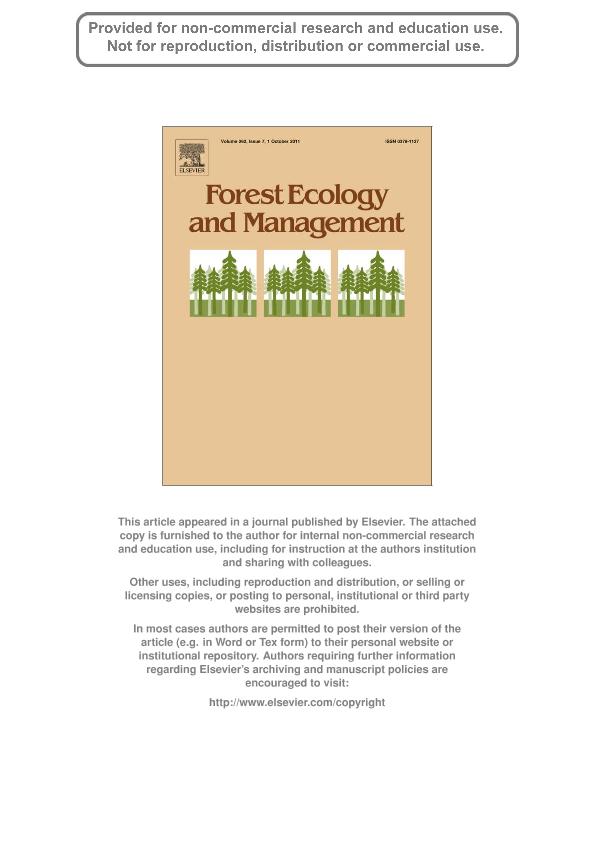Mostrar el registro sencillo del ítem
dc.contributor.author
Lencinas, María Vanessa

dc.contributor.author
Martínez Pastur, Guillermo José

dc.contributor.author
Gallo, Emilce Andrea
dc.contributor.author
Cellini, Juan Manuel

dc.date.available
2021-02-26T15:41:17Z
dc.date.issued
2011-10
dc.identifier.citation
Lencinas, María Vanessa; Martínez Pastur, Guillermo José; Gallo, Emilce Andrea; Cellini, Juan Manuel; Alternative silvicultural practices with variable retention to improve understory plant diversity conservation in southern Patagonian forests; Elsevier Science; Forest Ecology and Management; 262; 7; 10-2011; 1236-1250
dc.identifier.issn
0378-1127
dc.identifier.uri
http://hdl.handle.net/11336/126783
dc.description.abstract
Understory plants could can act as indicators of temperate forest sustainability, health and conservation status due to their importance in ecosystem function. Harvesting impacts on understory plant diversity depends on their intensity. Variable retention has been proposed to mitigate the harmful effects of timber harvesting, but its effectiveness remains unknown in southern Patagonian Nothofagus pumilio forests. The objectives of this study were to: (i) define a baseline of understory plant diversity in old-growth forests along a site quality gradient and under canopy gaps; (ii) evaluate stands with three different variable retention treatments compared to old-growth forests; and (iii) assess temporal changes during 4years after harvesting (YAH). A 61ha N. pumilio forest was selected. Understory plant (Dicotyledonae, Monocotyledonae and Pteridophyta) richness, cover (including woody debris and bare forest floor) and aboveground dry biomass were characterized in summer for 5years. Before harvesting, baseline samples were conducted along a site quality gradient and outside/inside canopy gaps. Analyzed treatments include a control of old-growth forest (OGF) and three different harvesting treatments with variable retention: (i) dispersed retention (DR) of 30m2ha-1 (20-30% retention); (ii) aggregated retention (AR) with one aggregate per hectare and clear-cuts (28% retention); and (iii) combined dispersed and aggregated retention (DAR) with one aggregate per hectare and dispersed retention of 10-15m2ha-1 (40-50% retention). Data analyses included parametric and permutational ANOVAs, multivariate classification and ordinations.Before harvesting, 31 plant species were found, where richness, cover and biomass were directly related to site quality. The presence of canopy gaps did not have a significant impact on the measured variables. After harvesting, 20 new species appeared from adjacent associated environments (two from N. antarctica forests and 18 from grasslands and peatlands). At the stand level, understory values were higher in AR > DR > DAR > OGF. Most (81-95%) plant richness at baseline conditions was conserved in all treatments, where inside the aggregates understory remained similar to OGF. Combination of aggregated and dispersed retention (DAR) better limited exotic species introduction and protected sensitive species, improving conservation in harvested stands. Changes in understory variables were observed after the first YAH in all treatments; greater changes were observed in the harvested areas than in aggregates. Changes stabilized at the fourth YAH. As a conclusion, the location of retention aggregates should be selected to preserve species understory diversity of more speciose and diverse habitats or particularly uncommon stands. Implementation of different kinds (patterns and levels) of retention for improvement of biodiversity conservation in harvested forests should be included in timber and forest management planning.
dc.format
application/pdf
dc.language.iso
eng
dc.publisher
Elsevier Science

dc.rights
info:eu-repo/semantics/openAccess
dc.rights.uri
https://creativecommons.org/licenses/by-nc-sa/2.5/ar/
dc.subject
AGGREGATED RETENTION
dc.subject
BIODIVERSITY CONSERVATION
dc.subject
DISPERSED RETENTION
dc.subject
PLANT DIVERSITY
dc.subject.classification
Silvicultura

dc.subject.classification
Agricultura, Silvicultura y Pesca

dc.subject.classification
CIENCIAS AGRÍCOLAS

dc.title
Alternative silvicultural practices with variable retention to improve understory plant diversity conservation in southern Patagonian forests
dc.type
info:eu-repo/semantics/article
dc.type
info:ar-repo/semantics/artículo
dc.type
info:eu-repo/semantics/publishedVersion
dc.date.updated
2021-02-10T17:00:03Z
dc.journal.volume
262
dc.journal.number
7
dc.journal.pagination
1236-1250
dc.journal.pais
Países Bajos

dc.journal.ciudad
Amsterdam
dc.description.fil
Fil: Lencinas, María Vanessa. Consejo Nacional de Investigaciones Científicas y Técnicas. Centro Austral de Investigaciones Científicas; Argentina
dc.description.fil
Fil: Martínez Pastur, Guillermo José. Consejo Nacional de Investigaciones Científicas y Técnicas. Centro Austral de Investigaciones Científicas; Argentina
dc.description.fil
Fil: Gallo, Emilce Andrea. Administración de Parques Nacionales; Argentina
dc.description.fil
Fil: Cellini, Juan Manuel. Universidad Nacional de La Plata; Argentina. Consejo Nacional de Investigaciones Científicas y Técnicas; Argentina
dc.journal.title
Forest Ecology and Management

dc.relation.alternativeid
info:eu-repo/semantics/altIdentifier/url/https://www.sciencedirect.com/science/article/abs/pii/S0378112711003835
dc.relation.alternativeid
info:eu-repo/semantics/altIdentifier/doi/https://doi.org/10.1016/j.foreco.2011.06.021
Archivos asociados
